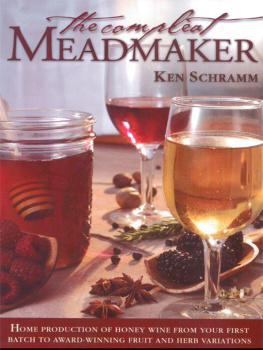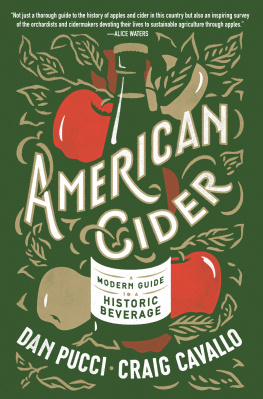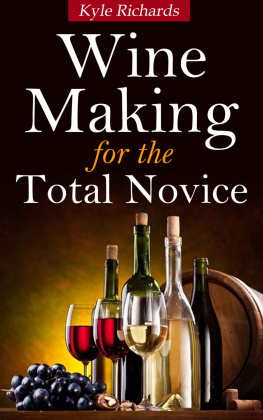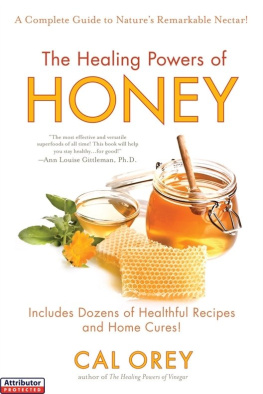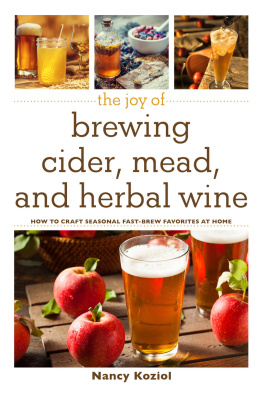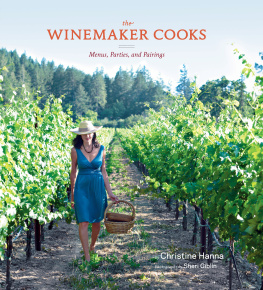
Brewers Publications
A Division of the Brewers Association
PO Box 1679, Boulder, CO 80306-1679
Telephone: (303) 447-0816 Fax: (303) 447-2825
www.beertown.org
2003 by Ken Schramm
All rights reserved.No portion of this book may be reproduced in any form without written permission of the publisher. Neither the author, editor nor the publisher assume any responsibility for the use or misuse of information contained in this book.
Printed in the United States of America.
10 9 8 7 6
ISBN-13: 978-0-937381-80-9
ISBN-10: 0-937381-80-2
Library of Congress Cataloging-in-Publication Data
Schramm, Ken, 1959-
The compleat meadmaker : home production of honey wine from your first batch to award-winning fruit and herb variations / by Ken Schramm.
p. cm.
Includes bibliographical references and index.
ISBN: 0-937381-80-2 (alk. paper)
1. Mead. I. Title.
TP588.M4S35 2003
641.872-dc21
2003009083
Technical Editor: Dick Dunn
Project Editor: Stan Hieronymus
Copy Editor/Indexing: Daria Labinsky
Special thanks to Redstone Meadery for contributing the meads shown on the front cover.
Cover photo by Rick Souders, Souders Studios
Interior photos by Jim Johnston and the National Honey Board
Cover and Interior Design by Julie Korowotny
table of contents
This book is dedicated to the memories of four great meadmakers.
To Dr. Robert Kime, Best-of-Show winner of the first Mazer Cup Mead Competition, whose work with honey and with ultrafiltration helped spur renewed interest in commercial meadmaking.
To Dr. Roger Morse, pioneer in modern meadmaking, beekeeper, scientist, author, and great contributor to the body of scientific knowledge about mead, and a man who lived with a deep dedication to this earth and the bounties that it gives us.
To Susanne Price, fierce and dedicated advocate of meadmaking, who bore the mantle of President of the American Mead Association until her untimely death in 1996.
And, most personally, to Dr. Bill Pfeiffer, 1987 American Homebrewers Association Mead Maker of the Year, who helped put knowledge of meadmaking into my soul, and who encouraged and taught me in the most profound and productive ways.
May they all be sharing a mazer in Valhalla.
More than anyone else, I need to thank my wife, Jean, and daughters Sarah and Alyson for putting up with the commitment it has taken to prepare this book. Their patience and forbearance have given me the latitude needed to complete this work, at the expense of their Internet access, the freedom to do their homework at their leisure, and worst of all, their playtime on the computer.
Dan McConnell showed me the finer points of meadmaking, and together we embarked on many crazed adventures concocted to learn more about mead. His knowledge of yeast varieties and fermentation has been integral to my understanding of that aspect of mead. Dan, Mike OBrien, Hal Buttermore, and I hatched a scheme many years ago to found the Mazer Cup Mead Competition. It has proven most instructive to all of us.
Larry Yates and the members of the Southeast Michigan Beekeepers Association have taught me much about honey, bees, and beekeeping. They have also taught me that the gentle, patient ways of beekeepers are to be admired and emulated.
Dr. Landis Donor and Dr. Jonathan White have generously shared their knowledge of honey and their materials with me. Theodore Grootendorst of Southmeadow Fruit Gardens taught me to graft, and instilled in me a deep thirst for knowledge of and experience tasting the many varieties of fruits (apples, especially) that can be grown in Michigan. Dr. Amy Iezonni of Michigan State University introduced me firsthand to the spectacular gamut of tart cherry varieties. Through conversation and the many transcripts he provided, Morten Meilgaard has helped me understand flavor and our perception of it.
Ray Daniels, Dick Dunn, Stan Hieronymus, and Daria Labinsky worked hard to make this a book that an intelligent human would not resent reading. It is a much better work for their efforts.
Last, but not least, I have to thank my father, Jim Schramm, who taught me that Dortmunder Union was way better than American beer; my grandfather, Harold Schramm, without whose counsel my attempts at orchardry would have suffered greatly; and my brother Mike, who bought me a beermaking kit for Christmas in 1987 and started me down a path that led here.
M ankinds record on taking care of its treasures leaves much to be desired. We have a habit of moving on to the next great fad, and forgetting everything worthwhile that has happened prior to fifteen minutes ago. We blindly allow our pace of life to be hastened beyond the pace at which life can be enjoyed, and fail even to take the time to ask ourselves what it is that life and our world offer us that give us pleasure and make it gratifying to await the change of the seasons. The cellular phones, answering machines, and Email meant to bring us freedom simply expand the amount of time we are accountable to our superiors and available to overcommit ourselves further. We abide by the rules and norms set before us by rulemakers, governments, and corporations, by advertising agencies, public opinion consultants, and management, and never stop to see if they make any sense or have any real value when viewed as part of the glorious web of life in which we spend our days.
Mead provides but one of a host of examples of this thoughtless rush into the future. Once the noblest of beverages in the northern European countries, it declined not due to its lack of worth, but rather as a casualty of it, as honey and its cherished product mead became affordable only to the extreme nobility and to the beekeeper. It was brushed aside in a maddening new rush of choices, novelty, and a love of convenience at all costs. The same can be said for cider, perry, and connoisseur fruits. Mead, once considered far superior to both wine and beer, fell into obscurity as honey became scarce and expensive, and was never reclaimed from the nobilitys vault in which it was laid. Through the work of many people, and by virtue of the quality of the beverage itself, mead is making a comeback. This book endeavors to push that comeback along.
The goal of this book is to bring the resources available to meadmakers nearer to the breadth of scientific knowledge and diversity of technique that are applied to amateur brewing and winemaking. I hope that these chapters provide a resource of new and valuable information about the various aspects of meadmaking that you can use to improve your mead. If you are totally new to meadmaking, youll soon be capable of making meads that compare with the best being made anywhere. If you have been making mead for several years, I hope The Compleat Meadmaker provides the type of information you have been seeking but have been unable to find compiled in one book elsewhere.
M ead has a rich tradition in every corner of the worldlongest, perhaps, away from its much-heralded northern European heritage. A comprehensive look at the documentation of the uses and distribution of mead around the globe and throughout history would easily fill an entire book. That, however, is not my sole goal, so I will focus on some of the less well-explored aspects of the history of this storied and fascinating drink.
THE GREAT DEBATE
When it comes to the title of The Oldest Fermented Beverage on Earth, each of the fermented beverage factions seeks to make the claim, and certainly the historical documentation of beer- and winemaking are substantial. In terms of written or pictorial evidence to bolster their argument, the beermakers currently have the upper hand, with pictorial records of beermaking that date back to Mesopotamia in about 4000 BC In the pictorial archaeological records of brewing and winemaking (about 3000 BC), each craft is depicted unmistakably and in a form that intimates that the activity had developed to a plateau wherein the process had become standardized. Wine- and beermaking had been undertaken for a sufficient period to become sources of employment and trade by the time these records were made.
Next page
